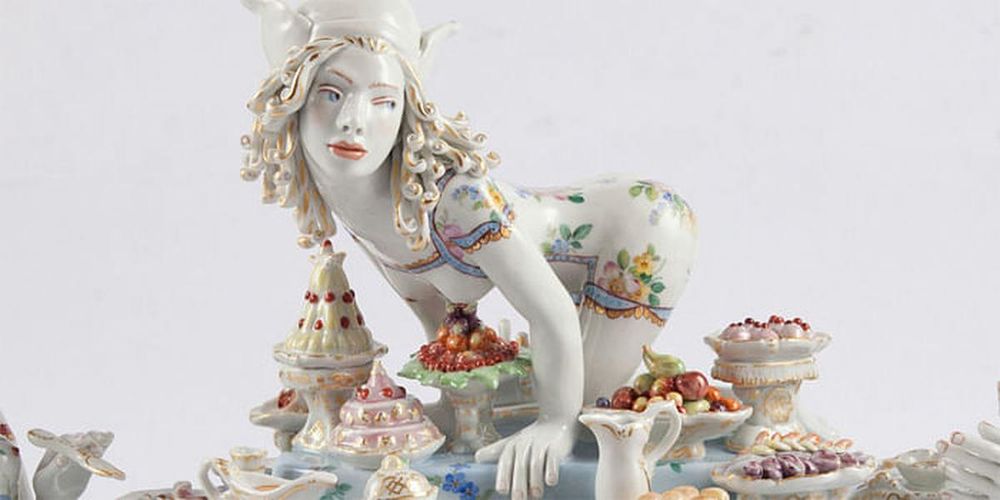The Most Risqué Sculptures You've Ever Seen
Two female artists are bringing feminist content to clay

Instead of playing the role of gracious hostess at a dinner party, Chris Antemann's women give their guests side-eye and prance around set tabletops. Rather than celebrate motherhood with unbridled enthusiasm, they express profound ambivalence.
In an effort to challenge the social expectations attached to responsibilities like cooking, entertaining, and child-rearing, which, more often than not, still fall to women, Antemann has created caricaturish versions of everyday scenes which rail against the notion that a woman's value is attached to the home. In her new exhibit "Forbidden Fruit," which opened at the Museum of Arts and Design last week, scantily clad women attend over-the-top dinner parties and seduce suitors atop luxurious, floral-printed beds. As if at a dreamy, 18th century banquet, the golden-haired characters treat themselves to decadent pastries, glistening layered cakes, and pastel-colored macarons. Yet unlike women from the 18th century, these women are not coy—they flirt unabashedly with male guests. They might be the most risqué porcelain women to enter a major New York City art museum.
Related article: Meet The Up-And-Coming Artist Who Won The BAZAAR Art Prize 2015
Here, Antemann is in good company. Her provocative characters come to life alongside another sculpture series located across the gallery floor, titled "Tell It By Heart," where Berkeley-based artist Coille Hooven explores how female identity evolves at different life stages. Hooven's milky white sculptures oscillate between being beautiful and disturbing, reflecting the artist's conflicting feelings about child-rearing and family life; where objects like house slippers, kitchen aprons, pillows, and slices of pie might seem sweet and simple on the surface, something sinister is often lurking underneath. For instance, in one work, a pair of eyes creep out from the pockets of a blouse, and in another, a snake's head emerges from a tuft of hair. This tension gets at the ambivalence the artist feels for keeping up with housekeeping duties and fulfilling the role of care provider for two young children. For Hooven, having children often restricted her artistic life; it brought periods of anguish (one sculpture hints at a miscarriage), but also pleasure and an expanded creative capacity (in some sculptures, she draws on fairy tales and children's fables).
"I wanted to take this static, female icon off her pedestal and give her her own party."
As the curator Shannon R. Stratton explains, these are "not just pretty pieces for the mantlepiece"—they are works charged with emotional meaning. "From maiden to middle age to being an older woman," Hooven's work shows us how bodily "transformations mold and shape our psychological states." In one work a woman is writhing with pain; in another, she is resting peacefully with one hand curved under her rotund, pregnant belly.
Oregon-based artist Antemann's installation, meanwhile, draws on biblical motifs which she flips on their head. When apples appear, they aren't the pristine, Eve-worthy apples used to symbolize knowledge and purity. As in one sculpture, where a figurine poses proudly with a partially eaten apple, the artist is challenging antiquated ideals about sexual purity, defying the notion that a woman's value is attached to her sexual activity. In reference to a seduction scene, Antemann explains that the subject is "offering [the apple] with full knowledge of what it is," and that "there is no innocence anymore." In other words, she takes ownership over her sexuality.
Related article: Yayoi Kusama’s Glass House Exhibition Will Be Your New Obsession
Whether traipsing over a tabletop laden with plates or posed seductively on a love seat, in Antemann's work the female subjects are always partially clothed while the men are usually nude. As the artist explains, the female characters play the dominant role in these narratives, which she signifies by giving them clothing. This power reversal means that the men are, as the artist put it, "the plus one" or the "second subject." (All the male characters are shown in the nude, with the exception of a few sculptures where Antemann painted clothing over the male figures' private parts to meet certain collectors' demands.)
When I ask Antemann about this representation of empowerment, she explains that she "wanted to take this static, female icon off her pedestal and give her her own party." In Hooven's work too, the female characters are always the subject, even when depicted diminutively, as peering out the lip of a vase, or abstractly, with facial features obfuscated by books, dice or other blockish objects. The subject of the works is still, consistently, the stuff of their lives.
Related article: Asia In Focus: 7 Local Artists Take On Singapore’s Most Beloved Icons
On the way to the stairs, museum-goers will encounter an alluring chandelier decorated with flowers, leaves, and lemons, suspended over Antemann's installation. The artist was inspired by the song "Lemon Tree" by Peter, Paul and Mary, especially the lyric: "Lemon tree very pretty and the lemon flower is sweet / but the fruit of the poor lemon is impossible to eat." This line is charged with sexual innuendo. In the dioramas, the female characters are empowered to flaunt their bodies and express their sexualities in myriad ways (including ménage à trois), but they are not, for lack of a better word, consumable.
While the women in Hooven's work yearn for pleasure and are burdened by the crush of domestic life, in Antemann's vignettes the subjects aren't burdened by anguish but engaged in playful explorations of their sexual selves. "I liken my work to dream interpretation," explains Hooven. "It is both literal and symbolic, intended to invoke a feeling that lingers. The shoe is a shoe, but also it is an animal, a vehicle, and a stage for the play within."
"Forbidden Fruit" and "Tell it By Heart" are on view at the Museum of Arts and Design from September 22, 2016 to February 5, 2017.
From: Harper's BAZAAR US